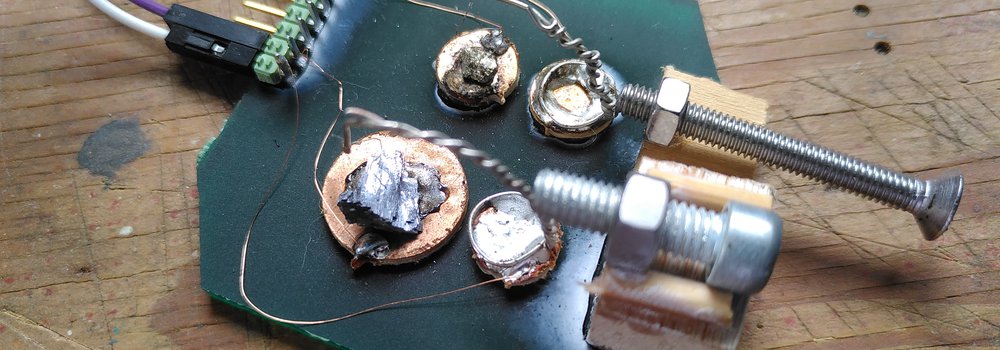We're really excited to have received a Flamm commission for a brand new project that is all about grounded approaches to exploring technology. This project has come about in response to a growth in a kind of tech mysticism, fuelled by a belief that the solution to our problems is to relinquish understanding to imagined higher powers. Whether they be by attributing agency to AI software to provide the "simple" answers we crave, or a long dreamt of takeover of robots to come to the rescue of our failing economies - this kind of thinking is based on a detached world of abundance, where there is always more power, more resources, more data - and having to consider otherwise is somehow embarrassing, or "someone else's problem to solve".
While this still seems to be (somehow) the prevailing worldview of big tech, for some time we have been quietly developing an approach to technology design based on collapse - not as a kind of prepping or doom-mongering, but as a recognition that perhaps designing things assuming the best possible situation might be problematic. We see better results for people if we start by examining the infrastructure any design or solution relies on. Doing more with less is of course the basis of creativity, and connecting our technology with the earth is a recognition, a celebration - of how much we actually have.
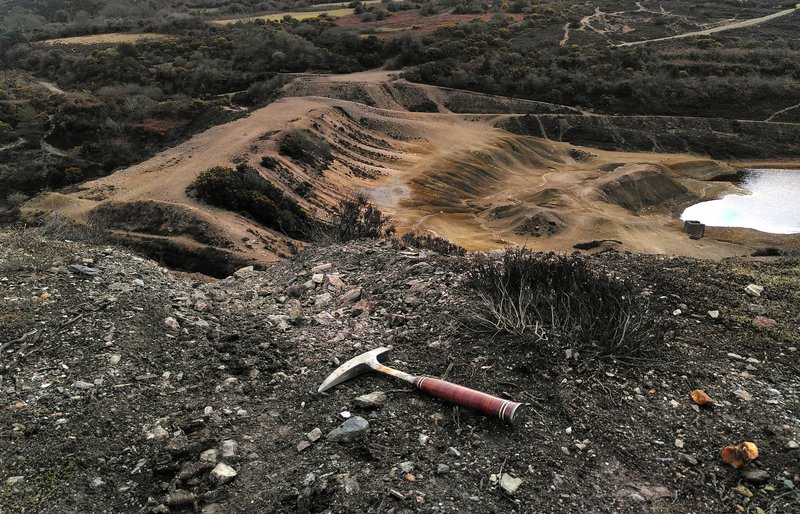
Image: a view from just in front of the East Wheal Maid mine shaft down into the Wheal Maid tailings dam, in Gwennap Cornwall. This place is known locally as "Cornish Mars". As is convention, my geological rock hammer included for scale.
For the last few months I've been busy fossicking (a Cornish word, also exported to Australia by immigrant miners, meaning collecting minerals from mine waste) around disused mining sites in Cornwall. My interest has been partly witnessing how environmental disaster areas from 200 years ago are gradually recovering (they are well hidden from tourists here) and partly learning a tiny slice of knowledge from the miners from these times by carefully examining the things they threw away. I've been recording finds on mindat.org, a kind of gigantic citizen science project to keep records of what minerals have been found across the world - which has really helped me get up to speed quickly.
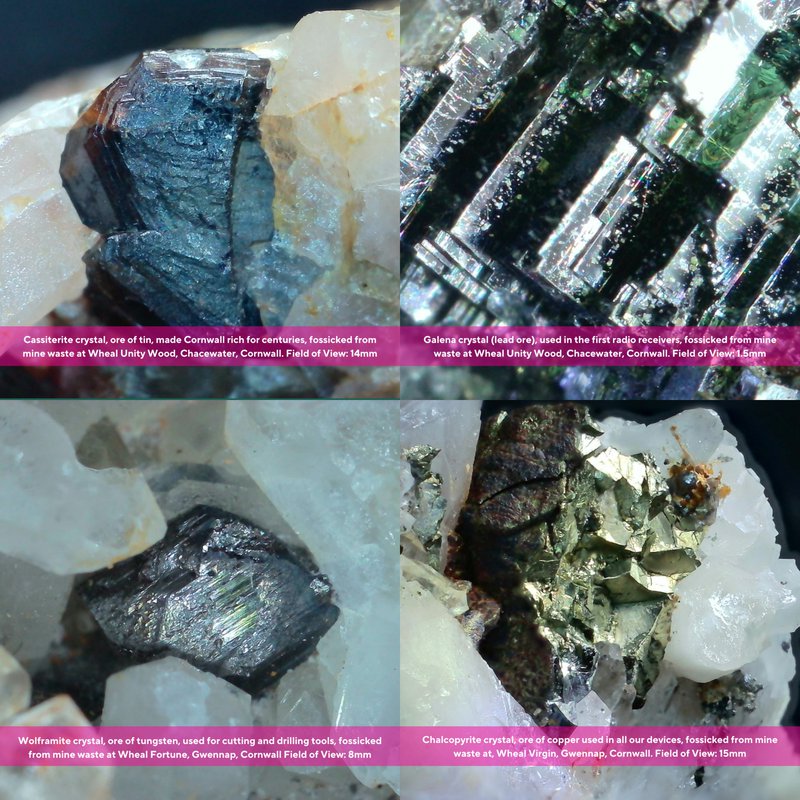
Image: four example minerals I collected from various sites, details in text image and alt-text.
Cornwall is unusual in that its geology was formed at the base of a mountain chain around 300 million years ago, and the metamorphic rocks contain an extremely wide range of different 'metalliferous' ores. Some of these have been extremely valuable (copper and tin) and others, such as arsenic and tungsten have also been extracted at different times. Gradually over the last hundred years mining has come to an end here, overtaken by Chile, Peru and China, with the most recent mines closing in the late 1970s.
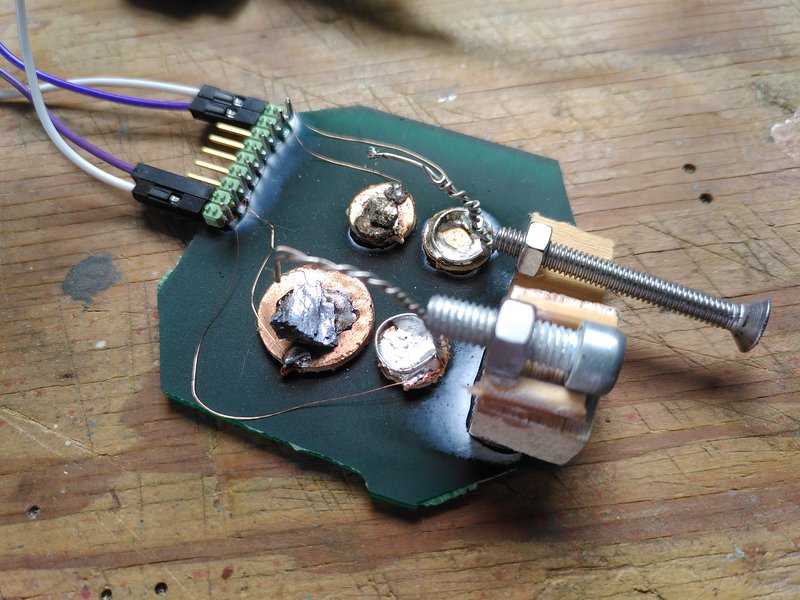
Image: Our current test setup - a brass coloured pyrite, and a silver galena crystal soldered to a small piece of copper clad board with two "cats whisker" wires "tickling" them. Nuts and bolts for fine tuning the pressure and connectors for attaching to a circuit.
Another history that is important to this project comes from the dawn of the semiconductor age, when minerals such as galena and pyrite were being widely experimented with to build electronics. It's quite tricky to unearth techniques from this time, but a few sites exist that keep documents as well as more recent experiments. Perhaps by working with these materials directly we can alter some of the suspension of disbelief that is required to learn about technology - to accept that a closed box (whether an iPhone, learning to code or how a transistor works) just does what it does via a kind of magic we don't question. Understandably, this seems hard for a lot of people to trust, so it's worth unpicking.
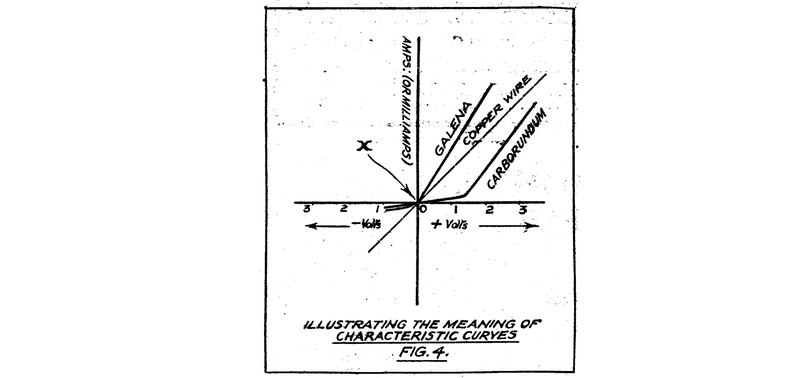
Image: How galena and carborundum semiconductors current varies against voltage from Popular wireless: crystal set experimenters handbook from October 1925
In order to design a workshop format for beginners that incorporates some of these concepts, starting with the mines and ending with circuits where we include our own semiconductors - requires a little basic scientific understanding. As much as anything else, we need to understand what isn't really important to go into, and why - and what are the interesting questions to ask. As in all our workshops, we treat participants as researchers with their own experience who can help us answer these questions, rather than people with a 'lack of knowledge' that needs 'fixing'.
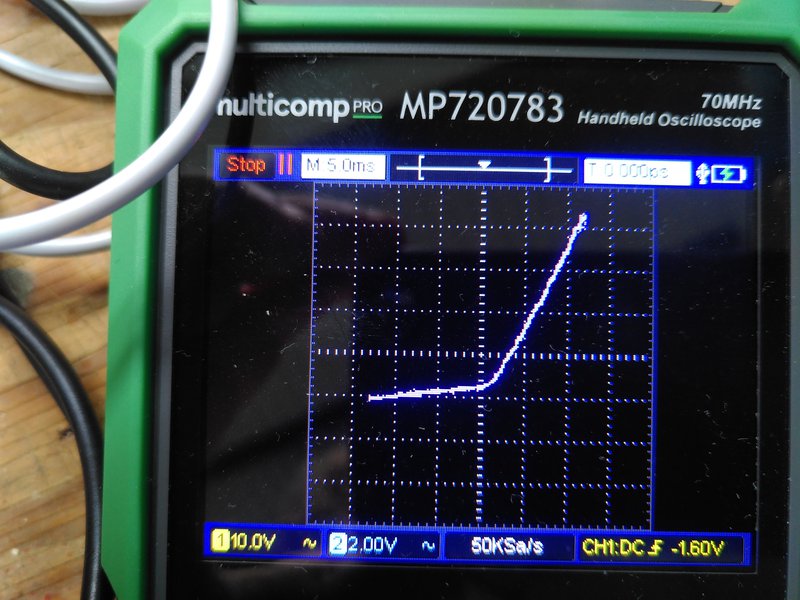
Image: Some work to do with the scales - but a plausible diode-like 'characteristic curve' for the pyrite crystal above, x scale is voltage (from -5V to +5V) and y scale is a measure of current (voltage across a series 1K resistor). Basically it's a bent line because it's reducing current flow at negative voltages on the left side, and we get a similar curve with a stock germanium diode.
The general concept will be based on:
- Starting with the earth - going out and visiting a mine site, looking into the lives of the people who worked there.
- Using sound as our primary medium of understanding - there are many reasons for this, partly we can begin to perceive the tiny periods of time involved with crystal atomic fluctuations sonically much more easily than other ways.
- There is very little practical information on many minerals that have semiconducting properties that can be found in Cornwall, such as wolfram or sphalerite - can we get them to do something interesting?
- Similarly, these minerals change, sometimes drastically - across different mining sites, sometimes within a mile of each other, or even within the same 'lode' (mineralised vein of rock). How do these changes alter their semiconducting behaviours?
- Using a spring connector + wires based approach to electronics that the participants can take home with them, that use a minimum of components to avoid the need for soldering or fiddly breadboards.


